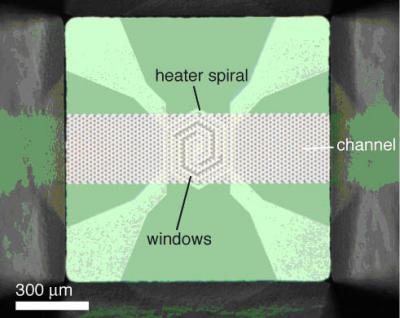MEMS nanoreactors for atomic-scale microscopy of nanomaterials under industrially relevant conditions (Nanoreactors)
In general, the properties of a catalyst on a macro scale depend strongly on the structure on the atomic scale. This structure includes the concentration of and the atomic arrangement in the exposed surfaces. The structure itself depends on the reaction environment, including the pressure, temperature, and gas composition.
To unravel the complex relations between material structure and properties we are developing a special tool: the MEMS nanoreactor. The nanoreactor is a miniaturized chemical reaction chamber which is extremely transparent, thereby enabling imaging of the reaction. It can be used in high-resolution transmission electron microscopes (HRTEM, TEM) or scanning transmission X-ray microscopes (STXM). Both instruments create high vacuum around the specimen. Normally they are therefore not suited for in situ imaging of gas�solid interactions.
The nanoreactor, however, creates a local environment of atmospheric pressure and temperatures up to 500 �C. Off-line, even 1000 �C and 14 bar have been reached. The environment is so thin that the microscope resolution down to the atomic scale is maintained. The nanoreactor thereby enables imaging of functioning nanomaterials under industrial conditions.
Our research focuses on the MEMS aspects of nanoreactors. So far, we have achieved:
- The first MEMS nanoreactor based on 10-nm thin windows of LPCVD SiN and a Pt heater. It enabled the imaging of a Cu-ZnO catalyst at 500 �C and 1 bar with atomic-scale resolution (0.18 nm). It was also used to monitor in situ phase changes in a complex iron-based Fischer�Tropsch catalyst and the nature and location of carbon species produced.
- Microheaters (microhotplates) of LPCVD SiC and sputtered Mo. Those materials extend the operating temperature well beyond 1000 �C while maintaining very low drift of the microscope image.
- Electron-transparent windows of LPCVD SiC. This material is considerably more robust in this application than conventional SiN.
- Wafer-bonded nanoreactors, which are much more reproducible than the first nanoreactors.
- Surface-micromachined nanoreactors. This technique enables a considerable improvement in maximum pressure (up to 14 bar) and transparency while further improving reproducibility.
For more information, see the
project homepage.

Project data
| Researchers: | Fredrik Creemer, Lina Sarro, Bruno Morana, Luigi Mele, J.C. Wolff |
|---|---|
| Starting date: | January 2011 |
| Closing date: | January 2015 |
| Sponsor: | Part of NIMIC |
| Contact: | Lina Sarro |